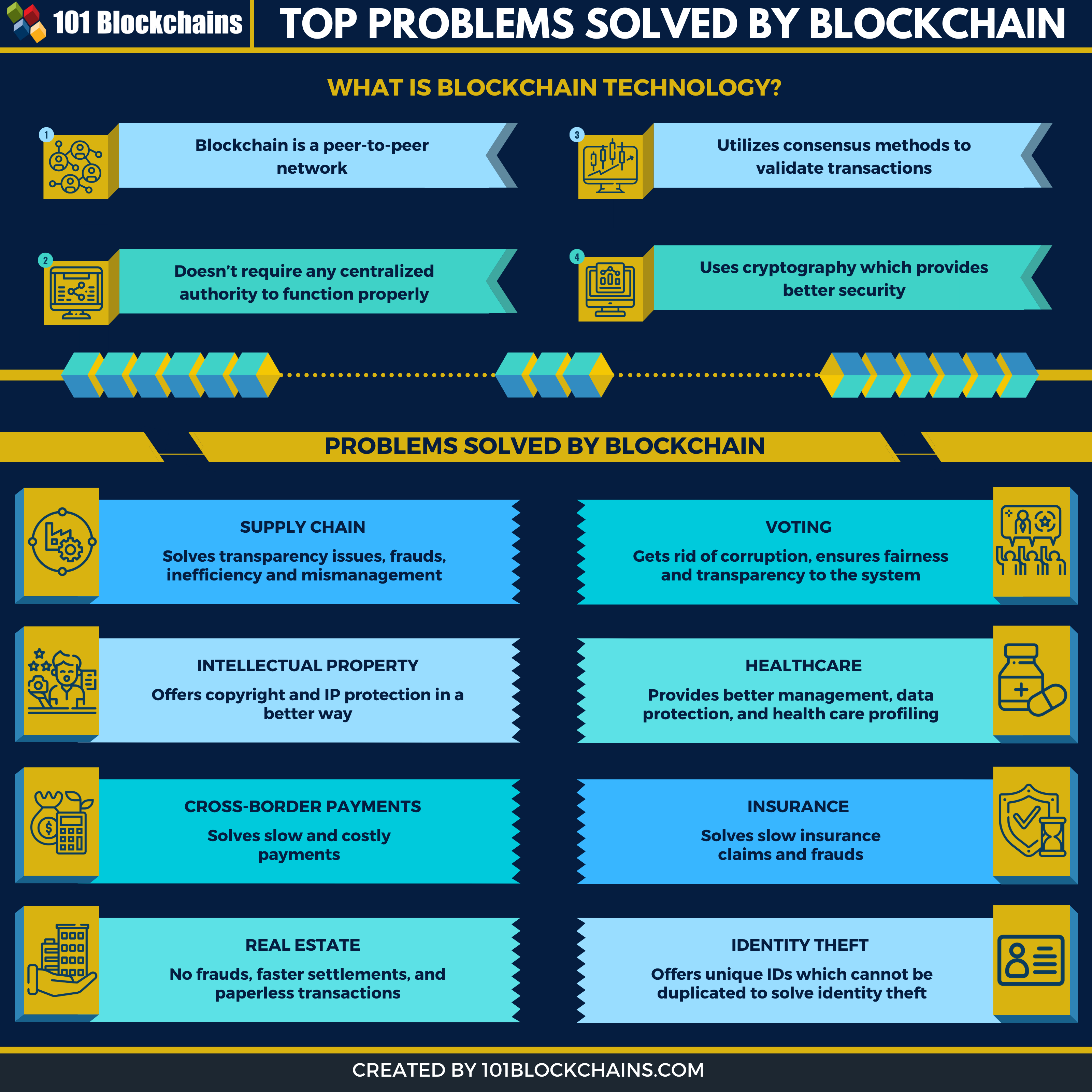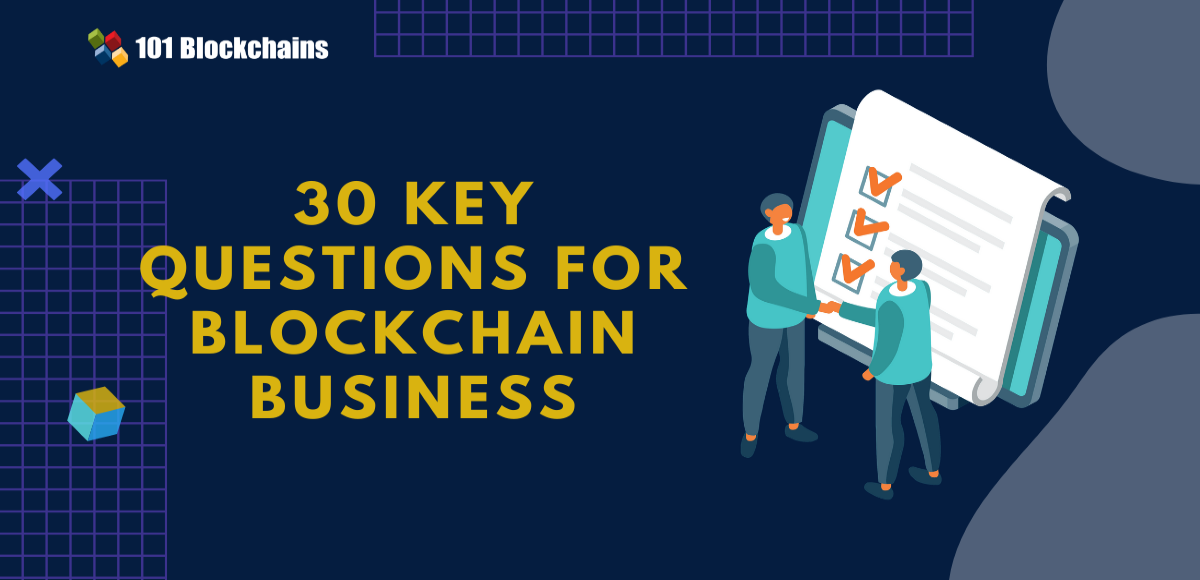Learn how blockchain truly works, master key definitions, and uncover what makes smart contracts so "smart." Dive into the fundamentals, gain valuable insights, and start your blockchain journey today!

- Opinions
101 Blockchains
- on June 30, 2020
Top Problems That Blockchain Solve
Are you looking to learn what problems blockchain solves? If you do, then you have come to the right place
If you have to name the top three technologies out there that are changing the world around us, then one of those technologies would be blockchain. There is no doubt that blockchain is growing. Even the numbers do not lie as the global blockchain market size is poised to grow from $3 billion USB in 2020 to an astounding $39.7 billion by 2025.
The biggest beneficiaries are the enterprise section of our society as they can streamline their work processes to make them more efficient, reliable, and scalable. We already have Hyperledger which is an open-source ecosystem of blockchain technologies aimed to provide enterprise tools, libraries, and frameworks for seamless development and deployment.
The end-users like you and me are also benefited. For instance, insurance handling can be improved manyfold thanks to automated evidence gathering and submission. Blockchain also removes the roles of many intermediaries, making the process more reliable, affordable, and fast!
All of these lead to just one question, “What problems does blockchain solve?”
In this article, we will demystify the problems solved by blockchain so that you can understand it more deeply. But, before we do so, let’s learn more about Blockchain and what it does?
Build your identity as a certified blockchain expert with 101 Blockchains’ Blockchain Certifications designed to provide enhanced career prospects.
What is Blockchain?
Blockchain is a network of peers where each peer can do transactions and share information without the need for a centralized authority. The peer-to-peer network is powered using consensus methods that validate the transactions. You can think of it as blocks that are chained together where each block contains transactions.
The data are once written to the block and are also immutable which makes it very hard for malicious actors to change or modify. One more thing that makes blockchain so amazing is the transparency it offers. If someone sends a transaction to another peer, then the transaction is broadcasted to every other peer so that it can be validated and stored.
The ability to function without a central authority brings a lot of opportunities to the users, especially big organizations that refine their services for the end-users.
In a nutshell, blockchain’s key features include the following:
- Blockchain is a peer-to-peer network
- Doesn’t require any centralized authority to function properly
- Utilizes consensus methods to validate transactions
- Uses cryptography which provides better security
- Other benefits of blockchain include transparency and immutability
There are other types of blockchain technology that use other forms of implementation and have other benefits. If you are interested then check out Hyperledger and Corda.
Blockchain Cannot Solve All The Problems
Another thing that we want to discuss is the exact role of blockchain. Theoretically, blockchain can be used in almost every sector out there.
However, it doesn’t mean that blockchain is meant to solve all the problems out there. It has surely started the cryptocurrency revolution, but there is still a long way to go before it can be deeply integrated into our society just like electricity and the internet.
But, right now, we can say that blockchain is promising. It can provide sustainable environments for different sectors where it can solve some aspects of it for now. With time, it can help resolve other more pressing core problems associated with it.
To help you understand the problems solved by blockchains, let’s list them and go through them one by one.
Problems Solved By Blockchain
-
Supply Chain
There is no doubt that the supply chain is at the core of our economy. Any problems in the supply chain can impact the whole network of businesses out there.
Currently, there are many different problems that the supply chain goes through. One of those problems includes the delay in the supply chain process, fraud, and the lack of transparency in the whole supply chain. All these problems are there because of the use of traditional methods and systems that are not interconnected to provide a seamless experience.
The network consists of multiple entities including manufacturers, supply chain providers, distributors, brick-and-mortar stores, businesses, and the end-user. If things do not work as intended, all the players suffer.
That’s why it is important to ensure the supply chain remains as efficient as possible. Also, another thing that needs to be resolved is fraud detection and removal.
Blockchain can help solve the problem with its transparency, immutability, and ability to track packages through the whole supply chain process. The information not only protects the goods from fraud but also ensures that the participants in the supply chain are informed as soon as something needs attention. Also, everyone in the supply chain is on the same page.
The real-time supply chain tracking also helps courier providers who can settle disputes with the available information.
Right now, there are many companies that are using blockchain for supply chains including Walmart for tracking food. They are working with IBM and using Hyperledger Fabric. OpenPort is also using blockchain to connect carriers and shippers through a cost-effective and highly reliable supply chain managed and powered by blockchain.
Excited to learn about the supply chain in blockchain? Enroll Now in Enterprise Blockchains and Supply Chain Management Course
-
Voting
There is no doubt that voting, even though, results in democratic governance, also brings its own problems with it. Clearly, there are many ways things can go wrong.
The voting can be rigged to benefit one party. The voting can be inaccessible as well which means many people who want to access their rights can not do so because of how it is conducted in the modern-day environment.
Even when clear voting takes place, there can be instances where the opposition party can create theories on how voting is rigged — which can result in unrest.
Blockchain can help to solve all these problems. It can help governments or other organizations to carry out the voting process in a transparent manner. As blockchain offers an immutable database, no votes can be altered after they are cast. It also provides a way to ensure that the voters are not frauds by providing each voter their own unique private key to log in to the system and then cast the vote.
If any dispute happens in the future, then the votes can be traced back and verified to ensure fair results.
Start your blockchain journey Now with the Enterprise Blockchains Fundamentals
-
Intellectual Property and Copyright
Every year, creators lose billions of dollars to copyright infringement. In the US alone, the TV and filmmakers lose $71 billion per year. Now, that’s a lot!
To protect their interest, they have a legal firm that looks out for this infringement and ensures that their intellectual properties remain safe to their best knowledge. In fact, they also hire third-party companies to look out for IP infringement and then claim the IP for them.
There is no doubt that creative people are suffering the most as their work is being used without their permission or any kind of payment. Also, as the internet is a big network, it is really hard for even the best solutions to find out about all the IP infringements.
Clearly, they need a better solution and that’s where blockchain comes in. With blockchain, creators can digitize their work which will result in better traceability.
For example, if someone’s creative work is digitized, metadata will be generated which will include the timestamp, ownership, and other key details required to protect the work. All of these are then stored in a blockchain which is immutable. The creator is now safe to share his work with the public.
As the content is digitized, it can be easily traced. The blockchain is also capable of informing the owner or the related agency about the copyright issue. The platform can also be automated to take legal action. All of these are possible because of how real-time transparency works in the blockchain.
Sony is one of the first movers when it comes to the adoption of blockchain for DRM.
-
HealthCare
It is important to emphasize how bad currently our healthcare is. We are currently in the mid-pandemic stage(Covid-19) and our healthcare systems are failing to cope with it. Apart from the immense pressure of new cases, one of the other reasons why our healthcare systems are failing is not using the right technology.
Currently, healthcare systems are heavily reliant on centralized systems to manage patients’ data. This can lead to issues and discrepancies when the patient changes the hospital or a new doctor or medical care expert is assigned to him.
Apart from that, the data stored in the hospital’s database are also not secure as key information including genomic testing, credit card testing, and other medical records are stolen and sold on the black market. Over 176 million patient records were compromised from the period of 2009 to 2017.
Blockchain can help solve all of these problems.
The first benefit that healthcare gets from blockchain is its decentralized nature. It can help create a better patient profile that can be uploaded and maintained on the blockchain itself. It can also help protect the patient’s data as blockchain utilizes cryptography to block all these networks.
Two main players who are using blockchain for healthcare include MedicalChain and BurstIQ which are providing health records integrity and security respectively.
Excited to learn why and what is Healthcare 3.0 – Ownership Health, Enroll now in Blockchain In Healthcare Masterclass
-
Cross-Border Payments
Another crucial problem that blockchain solves the cross-border payments. If you are someone who is working overseas and wants to send money to your family to stay at your native place, you need to take the help of your bank or any other payment provider to transfer the funds.
To start the payment, you first need to do the KYC procedure and then you will be eligible to send the amount. Also, the person to whom you are sending the amount also needs to have a bank or payments platform account.
In short, there are tons of dependencies if you want to go with the traditional route of doing cross-border payments.
Apart from that, you also need to wait a few days before the payment is processed by the payment provider. It happens because of the fact that there are plenty of rules and regulations put on by the government and as well as the banks that process their payment. However, few of them do provide payments in less time.
Meet Blockchain, a problem solver to all of the above problems.
It can be used to do instant cross-border payments without the need to go through a proper KYC process. It is so good that even banks use digital currencies to transfer huge amounts of funds. The transfer fees are also low compared to the traditional methods which give benefit to the sender.
Another thing that blockchain solves is the ability to send payments without the need to go through the institutionalized system.
-
Insurance
Just like the supply chain system, the insurance sector suffers from fraud as it tries to combat it every single day. Apart from fraud, the claims are time-consuming and not so user-friendly. As someone who is claiming insurance needs to connect with their agent and then it can take a day or two for the claims to get processed.
With blockchain, a lot of things will change. First of all, claims can be automated based on the information gathered during the incident.
So, if you have car insurance and your car is equipped with a proper communication device that records data, then the data can be used to validate the insurance, closing the claims in less than one day. This can change how insurance works and make people more satisfied when it comes to the claims process.
Want to know more about blockchain’s influence in the insurance industry? Check out our guide on blockchain for insurance use cases and applications now!
-
Real Estate
The real estate sector is another excellent example to showcase the blockchain’s capacity to solve problems. The current state of real estate is not great at all. First of all, a buyer needs to go through a very long process to acquire new property. Also, he needs to verify the property owners before he can buy them.
So, if you decide to buy a property now, it can take months before the deal is finalized. That’s not desirable for everyone out there. Blockchain solves the problem by providing a decentralized network to carry out the transactions. The real estate properties can be digitized to carry out this type of deal.
Also, a digital contract is created that includes all the necessary conditions for the purchase. For instance, the buyer can give token money to start the contract. With time, he can pay the amount to the seller and once all payment is done, the ownership is now changed to the buyer in a matter of minutes.
Propy is one of the companies that are using smart contracts to make buying and selling real estate faster and more secure!
Want to learn about the intersection of blockchain and real estate? Enroll Now in Blockchain For Real Estate Masterclass
-
Identity Theft
In the current world of connectivity, one big problem that internet users need to worry about is identity. It is easy to get your identity theft as the information about the person is easily available online through social media platforms or data breaches that happen quite often nowadays.
So, if a person suffers from identity theft, they can lose their friends or even the assets that they have saved throughout their life. Identity theft can lead to a loss of bank balance, credit card usage, and so on.
Blockchain can help solve the problem by providing everyone with a decentralized network where each person’s identity is unique and can only be present once. They will be given unique IDs that cannot be replicated or stolen.
There are already a few players that are providing digital identity in a more secure way. They include NewBanking and ValdiateID.
Start learning Blockchain with World’s first Blockchain Career Paths with quality resources tailored by industry experts Now!
Conclusion
This leads us to the end of our article where we discuss what problems blockchain solves. As you can see it can practically solve most of the crucial problems out there that connect with real people.
However, this doesn’t mean that blockchain adoption is at an all-time high. Infact, businesses are still not convinced that they need blockchain. This can be because of the challenges of blockchain implementation, its associated cost, maturity as a technology, and so on.
*Disclaimer: The article should not be taken as, and is not intended to provide any investment advice. Claims made in this article do not constitute investment advice and should not be taken as such. 101 Blockchains shall not be responsible for any loss sustained by any person who relies on this article. Do your own research!





![Future of Blockchain: Predictions for 2022 [UPDATED] future of blockchain predictions](https://101blockchains.com/wp-content/uploads/2020/12/future-of-blockchain-predictions.png)

